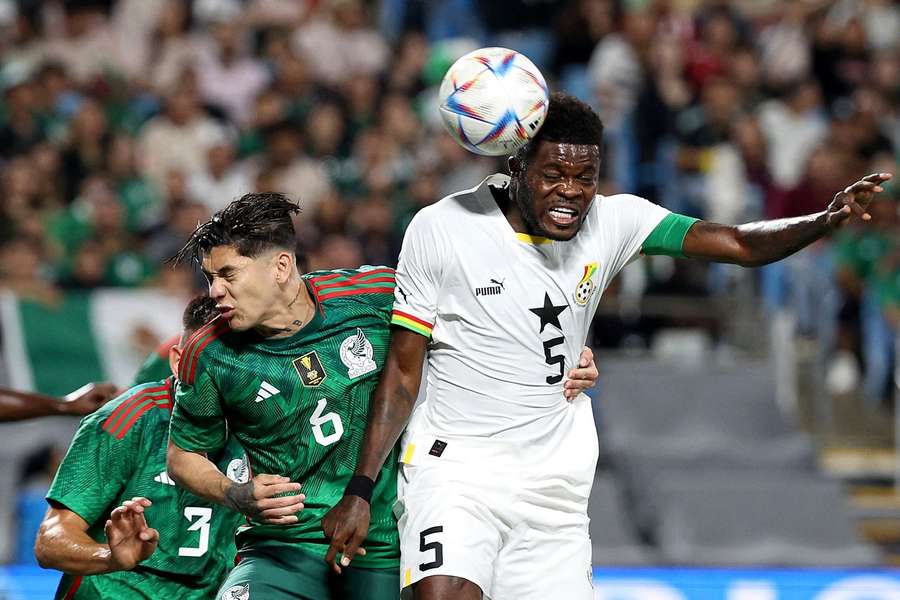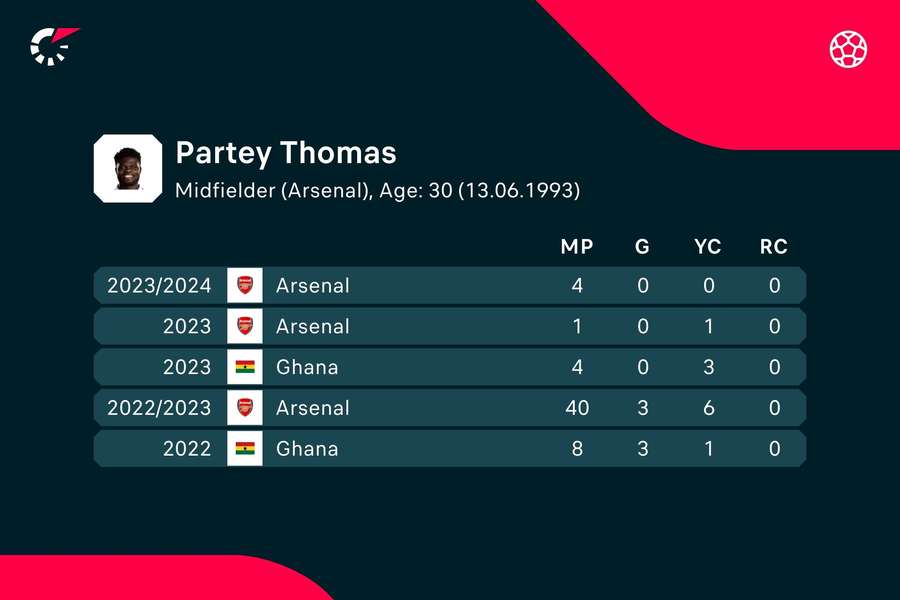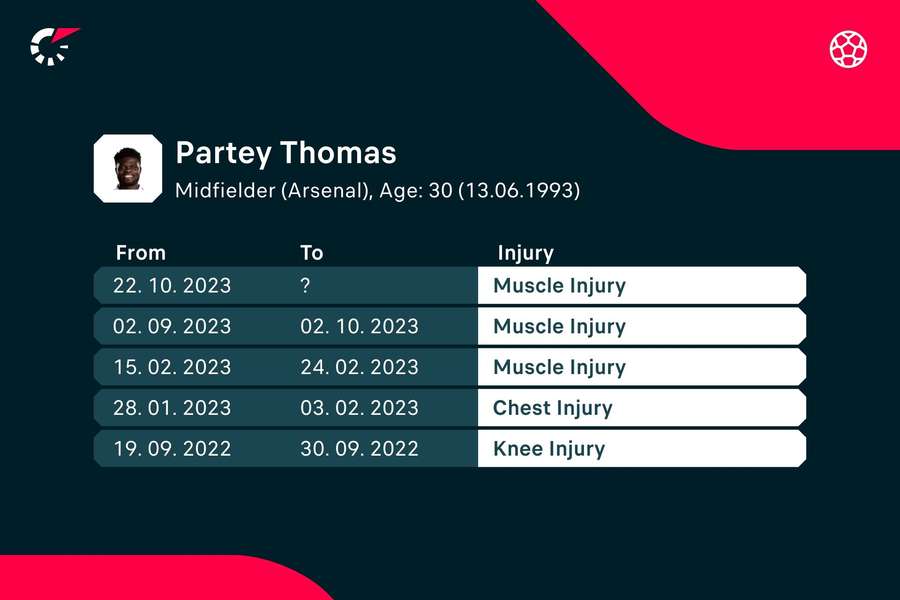Absence from the 2023 AFCON could tarnish Thomas Partey’s Ghana legacy

The majority of these players had their peaks behind them after the 2015 Africa Cup of Nations (AFCON) disappointment and the torch needed to be passed on.
Up stepped then 22-year-old Thomas Partey (30) who had just experienced his first taste of top-flight football whilst on loan at Almeria. His rise was pretty rapid only signing for Atletico Madrid’s reserve side four years prior. Despite being a teenager who had just made the 6,000km trip from Ghana to Europe, Partey stood out from his peers whenever he had the ball at his feet.
Javi Baños, who was the coach of Atletico Madrid’s academy in 2011, didn’t need to see Partey in a full match before being convinced. After the first half of a friendly match against Getafe, Baños knew they were going to keep the midfielder who he described as “good on the ball, could go past people, had a fine right foot, offered balance to the team and a really humble lad" to Marca.
After two loan spells at Mallorca and Almeria, Partey had his anticipated breakthrough season for Los Colchoneros. He made his debut on November 28th, 2015, against Espanyol and went on to make 23 appearances in all competitions including the Champions League final. Despite playing just 852 minutes all season, Partey still scored three goals and provided an assist. The call for Partey to be included in the Ghana squad grew stronger and in 2016 Avram Grant answered.
A Black Stars call long overdue
For many Ghanaians at the time, Partey’s call-up to the national team was long overdue but Grant wanted to be cautious with his initiation and only gave him a combined 25 minutes in his first two games against Mauritius and Rwanda. Grant had a trusted double pivot of Acquah and Wakaso and was ready to be patient with the midfielder.
Partey was handed his first start for the Black Stars against Russia albeit in a friendly game that saw him play 63 minutes. However, in the crucial must-win 2018 World Cup qualifier, Partey was an unused substitute as Uganda held Ghana to a goalless draw at the Tamale Stadium.
Partey was once again called upon in a friendly four days later as he played the entire game against South Africa - a match that ended 1-1. Five months after Partey’s debut for Ghana he had still not started a competitive game. That run came to an end as Grant included the Atletico Madrid man in his starting XI against Egypt in the World Cup qualifier. A six-pointer saw Ghana defeated 2-0 and as a result, lose more ground in the qualifiers.
All was quickly forgotten a couple of months later as the Black Stars went on a run in the AFCON and Partey played a pivotal role. By the time the tournament had come around the former Almeria player had seemingly displaced Acquah from the starting XI and partnered Wakaso for the most part. At just 24 years, Partey bossed the midfield offering the team balance in his bid to control games.
The midfielder breezed past opponents, distributed the ball effortlessly, and shielded his defence when necessary. The game against Mali was one of Partey’s best for Ghana as he was voted as man of the match even without scoring or assisting. CAF’s Technical Study Group highlighted Partey’s strength, agility, and finesse as the reasons why he was picked out as the standout player.
The efforts of Partey and Ghana were not enough as they finished fourth after losing to Cameroon and Burkina Faso in the semi-finals and third place play-off respectively. However, Partey was one of the few players who left Cameroon with their heads held up high.
For Partey everything changed after the tournament as he became one of the key players of the national team. There were whispers from Ghanaian fans comparing him to the great Essien. Although the 2018 World Cup qualifier turned out to be underwhelming, Partey’s hat-trick against Congo helped Ghana to their
only win of the campaign. Before the hat-trick, he scored his first-ever Black Stars goal in the reverse fixture to save a point at the Baba Yara sports stadium.
In 2018, Partey embraced a new challenge and wore the armband during the June/July international break. He scored a cracking free-kick against Japan in a 2-0 win and a well-taken equaliser against Iceland. The goal against Iceland demonstrated his goal-scoring instincts as his movement and one-time finish took the opponent by surprise.

The position conundrum
Partey’s array of goals for Ghana by 2018 inspired fans to start demanding that he be moved further upfront into the number 10 position. The belief was that with his shot power and ability to find spaces in the box, he could help ease the goal-scoring burden on Gyan.
That was the beginning of the unending debate on what Partey’s best position is; is he a lone defensive midfielder? Can he play as a number 8 or box-to-box? Should he play behind the striker? These are questions that different coaches have been trying to answer when it comes to how Partey is deployed in the national team.
In Partey’s seven years with the national team, he’s worked with six coaches - averaging almost a coach every year. The issue is every coach has varying ideas which usually factor into how they want to play. Grant tried Partey in attacking midfield before settling with him as a defensive midfielder. Under Kwesi Appiah, he once again shuffled between different midfield roles and even played as a right back in an AFCON qualifier against Kenya.
CK Akonnor knew what he wanted and played Partey in a double pivot whenever he was available. Milovan Rajevac and Otto Addo took a page out of Akonnor’s book and for the most part, played him in a double pivot except the latter sometimes gave the midfielder more freedom to roam. Perhaps Chris Hughton who served as technical advisor to Addo had a hand in that as his role has evolved with fewer limitations in midfield. Whenever Partey plays now under Hughton, it’s usually with a lone defensive midfielder in the form of Edmund Addo or Salis Samed. This allows the Arsenal man to pick up spaces in midfield to help Ghana build up in possession.
Partey started his career as an attacking midfielder but his orientation at club level has reshaped him to become more of a central midfielder. His lack of game time at club level as an advanced midfielder will make it difficult for any coach to experiment with that with the national team. Especially when there are players like Mohammed Kudus and Andre Ayew already competing for the number 10 role.

Injuries that won’t go away
Since the start of the 2020/21 season when Partey made his big-money move to Arsenal, he’s missed 21 out of a possible 38 possible games for Ghana due to injury. In that period, he’s had to deal with nine different injuries, five of which are muscle-related.
Muscle injuries tend to be more susceptible to aggravation and that has been the case for Partey who just can’t catch a break at the moment. The deputy Ghana captain has undergone a specialist procedure for treatment of his recent thigh injury and is now set to miss the rest of 2023.
This means Partey will end the year having played only four out of nine games for the Black Stars in the calendar year. At 30, it is difficult to see his injury record getting any better considering whenever he recovers he will be thrown into one of the most intense leagues in the world. It is the reason why Arsenal have tried to manage the Ghanaian in the past few months. During the March and October international windows, the London club sent physiotherapist Simon Murphy to accompany Partey and monitor him during training and matches.
There is an over-reliance on Partey when it comes to Ghana and unlike Arsenal, who went on to sign Declan Rice last summer, the West African country hasn’t put into thought what life after Partey will be. The warning signs have been clear with the number of matches missed but there isn’t a cutout replacement for the Arsenal man. Whenever he’s absent the team struggles to control games and assert themselves on opponents.
As things stand, there is the risk he might miss the AFCON in January which will be a big loss to Ghana. On a personal level, it will even be a bigger loss to Partey. The 2017 AFCON was memorable but history will always remember it as the end of a golden generation for the Black Stars. It marked the culmination of a team that reached the semi-finals of the AFCON six successive times. Since then his biggest moment has been scoring the goal that sent Ghana to the 2022 World Cup. If that was to be the first time Ghana ever qualified for the Mundial, that goal would gain a lot more relevance but that isn't the case.
For all his performances at club level, Partey needs a legacy tournament to enter the elite tier when it comes to the history of Ghanaian footballers. In the case of Essien, the 2008 AFCON was all it took and even then Ghana didn’t win the tournament. Similar to Gyan at the 2010 World Cup in South Africa. Ghana football has sunk in the past few months; a disastrous AFCON followed by an underwhelming World Cup campaign.
If Partey could lead Ghana in Ivory Coast and make Ghanaians reminisce of the good times once again, he would write his name in the country’s football folklore.
